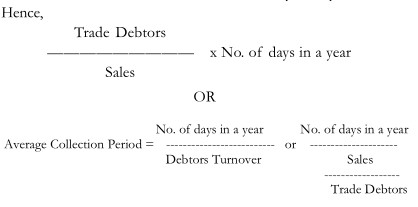The efficiency, with which the assets are utilized or converted into sales, is evaluated with these ratios. The speed at which assets are converted into sales is reflected in these ratios.
Inventory or Stock Turnover Ratio
Inventory Turnover Ratio measures the velocity of the movement of goods. It measures the relationship between the Cost of Goods Sold and the Inventory level.
Inventory Turnover = Cost of Goods Sold / Average Inventory
Cost of goods sold = Opening stock + Purchases and Manufacturing Cost – Closing Stock
Average Inventory = (Opening Stock + Closing Stock) / 2
The average time taken for clearing the stocks is calculated as follows:
Inventory conversion period = Number of days in a year / Inventory Turnover Ratio
Generally, high inventory ratio implies good inventory management. But it may indicate under-investment which means loss of business opportunities. Similarly, a low inventory turnover may be indicative of over-investment which is still worse evil. Hence what is required is the optimum inventory level.
The Inventory Turnover Ratio can be extended to the components of inventory: (i) Raw materials and (ii) Work-in-progress. This may examine the efficiency with which the raw materials are converted into work-in-progress and work-in-progress to finished goods. Raw Materials inventory is related to Materials Consumed and work-in-progress to the Cost of Goods Manufactured.
Debtors or (Accounts) Receivables Turnover Ratio and Average Collection Period
Debtors Turnover Ratio measures the efficiency at which the sales are converted into cash
Debtors Turnover = Credit Sales / Average Trade Debtors
Average Collection Period:
Average Collection Period represents the average number of days for which a firm has to wait for converting a receivable into cash.
Average Collection Period = Trade Debtors / Average Sales per day
Average Sales per day= Sales / No. of days in a year

To supplement the information, Ageing Schedule may be use to ascertain the quality of the trade debtors to identify the areas of problems in debtors.
Assets Turnover Ratios
Assets Turnover Ratios measure the efficiency of the assets in generating sales
Total Assets Turnover
To ascertain the ability to generate sales from all financial resources
Cost of Goods Sold or Sales / Total Assets
Fixed and Current Assets Turnover Ratio
To ascertain the adequacy of investment in fixed and current assets
Fixed Assets Turnover Ratio = Cost of Goods Sold or Sales / Fixed Assets
Current Assets Turnover Ratio = Cost of Goods Sold or Sales / Current Assets
Working Capital Turnover Ratio
To ascertain the efficiency with which working capital is utilized in the business
Working Capital Turnover Ratio = Cost of Goods Sold or Sales / Net Working Capital
Profitability Ratio
All the stakeholders are interested in assessing the profitability of a firm, more interested are the owners and the management. Profit is the final measure of performance of a firm. Profit is the basic thing for survival and growth of a business.
Profitability Ratios can be related to sales as well as investments.

